SDO
Solar Dynamics Observatory
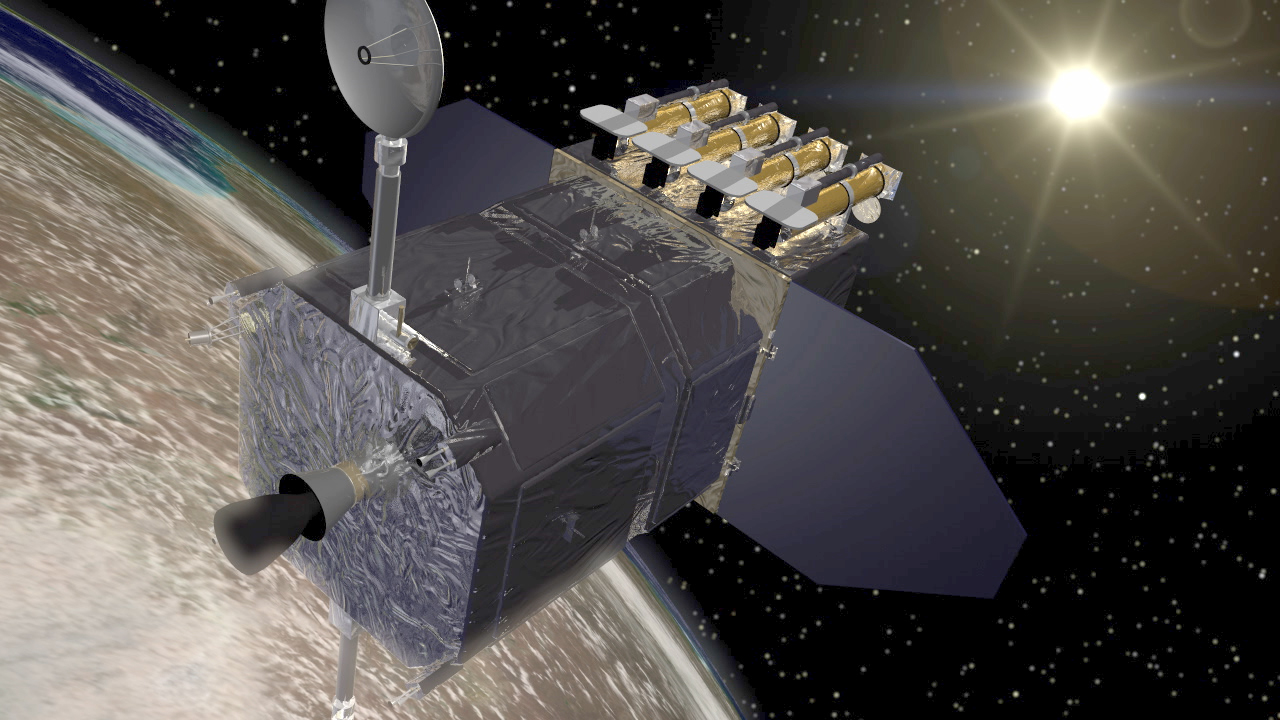
Our sun is ever-changing, and the Solar Dynamics Observatory (SDO) has a front-row seat.
On Feb. 11, 2010, NASA launched the Solar Dynamics Observatory, also known as SDO. SDO keeps a constant eye on the sun, helping us track everything from sunspots to solar flares to other types of space weather that can have an impact on Earth. For instance, solar activity is behind the aurora, one of Earth’s most dazzling natural events.
SDO is designed to help us understand the Sun’s influence on Earth and Near-Earth space by studying the solar atmosphere on small scales of space and time and in many wavelengths simultaneously.
The Solar Dynamics Observatory (SDO) is the first mission to be launched for NASA’s Living With a Star (LWS) Program, a program designed to understand the causes of solar variability and its impacts on Earth.
SDO’s goal is to understand, driving towards a predictive capability, the solar variations that influence life on Earth and humanity’s technological systems by determining:
- how the Sun’s magnetic field is generated and structured
- how this stored magnetic energy is converted and released into the heliosphere and geospace in the form of solar wind, energetic particles, and variations in the solar irradiance.
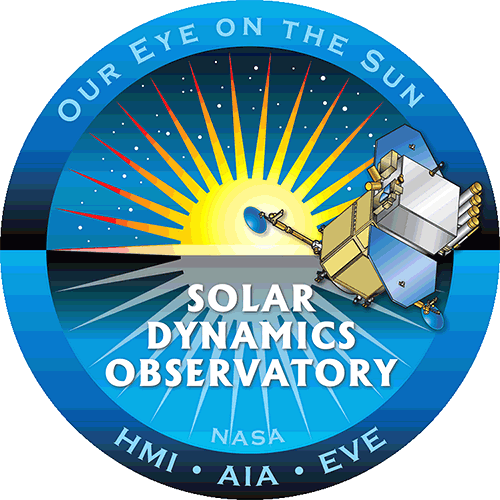
Seeing the Sun in Many Wavelengths
Each of the wavelengths observed by NASA’s Solar Dynamics Observatory (SDO) was chosen to emphasize a specific aspect of the sun’s surface or atmosphere. The “false colors” are chosen to best highlight features in each wavelength.
This image shows imagery both from the Advanced Imaging Assembly (AIA), which helps scientists observe how solar material moves around the sun’s atmosphere, and the Helioseismic and Magnetic Imager (HMI), which focuses on the movement and magnetic properties of the sun’s surface.
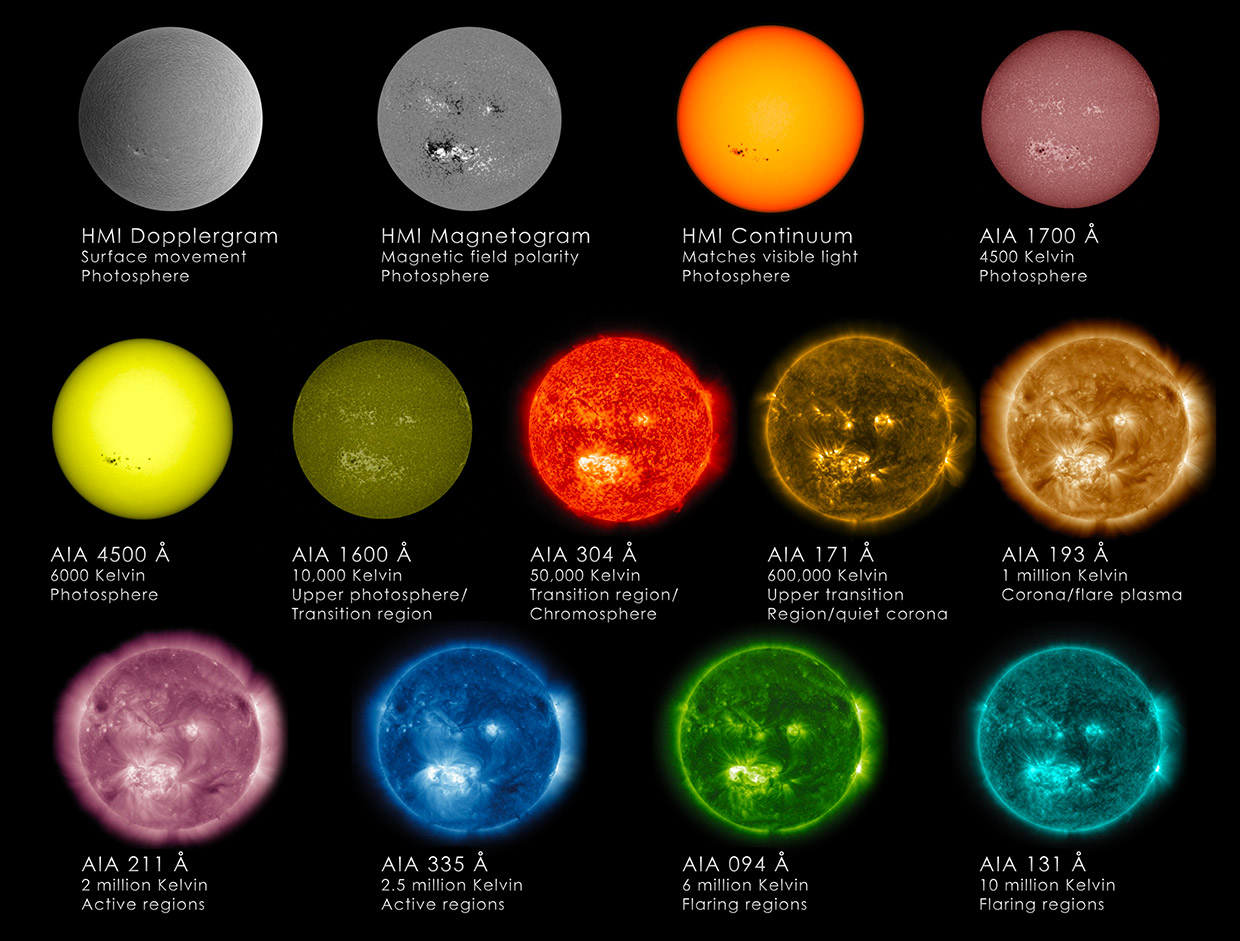
The sun’s activity rises and falls in a pattern that lasts about 11 years on average. This is called the solar cycle. After seven years in space, SDO has had a chance to do what few other satellites have been able to do – watch the sun for the majority of a solar cycle in 11 types of light.
SDO: Year 10
In February 2020, NASA’s Solar Dynamics Observatory — SDO — is celebrating its 10th year in space.
Over the past decade the spacecraft has kept a constant eye on the Sun, studying how the Sun creates solar activity and drives space weather — the dynamic conditions in space that impact the entire solar system, including Earth. Since its launch on Feb. 11, 2010, SDO has collected millions of scientific images of our nearest star, giving scientists new insights into its workings. SDO’s measurements of the Sun — from the interior to the atmosphere, magnetic field, and energy output — have greatly contributed to our understanding of our closest star. SDO’s images have also become iconic — if you’ve ever seen a close-up of activity on the Sun, it was likely from an SDO image.
CREDITS: Music: “Unseen Husband“ from Universal Production; Music Credit: NASA’s Goddard Space Flight Center Scott Wiessinger (USRA); Lead Producer Mara Johnson-Groh (Wyle Information Systems); Science Writer Barb Mattson (University of Maryland College Park): Narrator
SDO: Year 7
The Solar Dynamics Observatory (SDO) has now captured nearly seven years worth of ultra-high resolution solar footage.
This time-lapse shows that full run from two of SDO’s instruments. The large orange sun is visible light captured by HMI. The smaller golden sun is extreme ultraviolet light from AIA and reveals some of the suns atmosphere, the corona. Both appear at one frame every 12 hours. SDO’s nearly unbroken run is now long enough to watch the rise and fall of the current solar cycle. The graph of solar activity shows the sunspot number, a measurement based on the number of individual spots and the number of sunspot groups. In this case, the line represents a smoothed 26-day average to more clearly show the overall trend.
CREDIT: NASA/Goddard Space Flight Center/SDO, Music: “Web of Intrigue” from Killer Tracks.
SDO: Year 6
This video shows the sun in the 171 angstrom wavelength of extreme ultraviolet light. It covers a time period of January 2, 2015 to January 28, 2016 at a cadence of one frame every hour, or 24 frames per day.
This timelapse is repeated with narration by solar scientist Nicholeen Viall and contains close-ups and annotations. 171 angstrom light highlights material around 600,000 Kelvin and shows features in the upper transition region and quiet corona of the sun.
The sun is always changing and NASA’s Solar Dynamics Observatory is always watching. Launched on Feb. 11, 2010, SDO keeps a 24-hour eye on the entire disk of the sun, with a prime view of the graceful dance of solar material coursing through the sun’s atmosphere, the corona. SDO’s sixth year in orbit was no exception. This video shows that entire sixth year–from Jan. 1, 2015 to Jan. 28, 2016 as one time-lapse sequence. At full quality, this video is ultra-high definition 3840×2160 and 59.94 frames per second. Each frame represents 1 hour.
SDO’s Atmospheric Imaging Assembly (AIA) captures a shot of the sun every 12 seconds in 10 different wavelengths. The images shown here are based on a wavelength of 171 angstroms, which is in the extreme ultraviolet range and shows solar material at around 600,000 Kelvin (about 1 million degrees F.) In this wavelength it is easy to see the sun’s 25-day rotation.
During the course of the video, the sun subtly increases and decreases in apparent size. This is because the distance between the SDO spacecraft and the sun varies over time. The image is, however, remarkably consistent and stable despite the fact that SDO orbits Earth at 6,876 mph and the Earth orbits the sun at 67,062 miles per hour.
Scientists study these images to better understand the complex electromagnetic system causing the constant movement on the sun, which can ultimately have an effect closer to Earth, too: Flares and another type of solar explosion called coronal mass ejections can sometimes disrupt technology in space. Moreover, studying our closest star is one way of learning about other stars in the galaxy. NASA’s Goddard Space Flight Center in Greenbelt, Maryland. built, operates, and manages the SDO spacecraft for NASA’s Science Mission Directorate in Washington, D.C.
CREDIT: NASA/Goddard Space Flight Center/SDO, Music: “Tides” and is from Killer Tracks.
SDO: Year 5
Highlights from the Solar Dynamics Observatory’s five years of watching the sun.
February 11, 2015 marks five years in space for NASA’s Solar Dynamics Observatory, which provides incredibly detailed images of the whole sun 24 hours a day. Capturing an image more than once per second, SDO has provided an unprecedentedly clear picture of how massive explosions on the sun grow and erupt ever since its launch on Feb. 11, 2010. The imagery is also captivating, allowing one to watch the constant ballet of solar material through the sun’s atmosphere, the corona.
In honor of SDO’s fifth anniversary, NASA has released a video showcasing highlights from the last five years of sun watching. Watch the movie to see giant clouds of solar material hurled out into space, the dance of giant loops hovering in the corona, and huge sunspots growing and shrinking on the sun’s surface.
The imagery is an example of the kind of data that SDO provides to scientists. By watching the sun in different wavelengths – and therefore different temperatures – scientists can watch how material courses through the corona, which holds clues to what causes eruptions on the sun, what heats the sun’s atmosphere up to 1,000 times hotter than its surface, and why the sun’s magnetic fields are constantly on the move.
Five years into its mission, SDO continues to send back tantalizing imagery to incite scientists’ curiosity. For example, in late 2014, SDO captured imagery of the largest sun spots seen since 1995 as well as a torrent of intense solar flares. Solar flares are bursts of light, energy and X-rays. They can occur by themselves or can be accompanied by what’s called a coronal mass ejection, or CME, in which a giant cloud of solar material erupts off the sun, achieves escape velocity and heads off into space. In this case, the sun produced only flares and no CMEs, which, while not unheard of, is somewhat unusual for flares of that size. Scientists are looking at that data now to see if they can determine what circumstances might have led to flares eruptions alone.
Goddard built, operates and manages the SDO spacecraft for NASA’s Science Mission Directorate in Washington, D.C. SDO is the first mission of NASA’s Living with a Star Program. The program’s goal is to develop the scientific understanding necessary to address those aspects of the sun-Earth system that directly affect our lives and society.
CREDIT: NASA/Goddard Space Flight Center/SDO, Music:”Expanding Universe” and “Facing the Unknown” both from Killer Tracks.
SDO: Year 4
Massive solar flares, graceful eruptions of solar material, and an enormous sunspot make up some of the imagery captured by NASA’s Solar Dynamics Observatory during its fourth year in orbit.
The sun is always changing and NASA’s Solar Dynamics Observatory is always watching. Launched on Feb. 11, 2010, SDO keeps a 24-hour eye on the entire disk of the sun, with a prime view of the graceful dance of solar material coursing through the sun’s atmosphere, the corona. SDO’s fourth year in orbit was no exception: NASA is releasing a movie of some of SDO’s best sightings of the year, including massive solar explosions and giant sunspot shows.
SDO captures images of the sun in 10 different wavelengths, each of which helps highlight a different temperature of solar material. Different temperatures can, in turn, show specific structures on the sun such as solar flares, which are giant explosions of light and x-rays, or coronal loops, which are streams of solar material traveling up and down looping magnetic field lines. The movie shows examples of both, as well as what’s called prominence eruptions, when masses of solar material leap off the sun. The movie also shows a sunspot group on the solar surface. This sunspot, a magnetically strong and complex region appearing in mid-January 2014, was one of the largest in nine years.
Scientists study these images to better understand the complex electromagnetic system causing the constant movement on the sun, which can ultimately have an effect closer to Earth, too: Flares and another type of solar explosion called coronal mass ejections can sometimes disrupt technology in space. Moreover, studying our closest star is one way of learning about other stars in the galaxy. NASA’s Goddard Space Flight Center in Greenbelt, Md. built, operates, and manages the SDO spacecraft for NASA’s Science Mission Directorate in Washington, D.C.
CREDIT: NASA/Goddard Space Flight Center/SDO, Music: Stella Maris courtesy of Moby Gratis.
SDO: Year 3
The sun’s greatest hits as captured by the Solar Dynamic Observatory from February 2012 to February 2013.
On Feb. 11, 2010, NASA launched an unprecedented solar observatory into space. The Solar Dynamics Observatory (SDO) flew up on an Atlas V rocket, carrying instruments that scientists hoped would revolutionize observations of the sun. If all went according to plan, SDO would provide incredibly high-resolution data of the entire solar disk almost as quickly as once a second.
When the science team released its first images in April of 2010, SDO’s data exceeded everyone’s hopes and expectations, providing stunningly detailed views of the sun. In the three years since then, SDO’s images have continued to show breathtaking pictures and movies of eruptive events on the sun. Such imagery is more than just pretty, they are the very data that scientists study. By highlighting different wavelengths of light, scientists can track how material on the sun moves. Such movement, in turn, holds clues as to what causes these giant explosions, which, when Earth-directed, can disrupt technology in space.
SDO is the first mission in a NASA’s Living With a Star program, the goal of which is to develop the scientific understanding necessary to address those aspects of the sun-Earth system that directly affect our lives and society. NASA’s Goddard Space Flight Center in Greenbelt, Md. built, operates, and manages the SDO spacecraft for NASA’s Science Mission Directorate in Washington, D.C.
CREDIT: NASA/Goddard Space Flight Center/SDO, Music: Mistake (Davide Rossi Re-Work – Instrumental) courtesy of Moby Gratis.
SDO: Year 2
April 21, 2012 marks the two-year anniversary of the Solar Dynamics Observatory (SDO) First Light press conference, where NASA revealed the first images taken by the spacecraft.
This video highlights just some of the amazing events witnessed in SDO’s second year. CREDIT: NASA/Goddard Space Flight Center/SDO
SDO: Year One
April 21, 2011 marks the one-year anniversary of the Solar Dynamics Observatory (SDO) First Light press conference, where NASA revealed the first images taken by the spacecraft.
In the last year, the sun has gone from its quietest period in years to the activity marking the beginning of solar cycle 24. SDO has captured every moment with a level of detail never-before possible. The mission has returned unprecedented images of solar flares, eruptions of prominences, and the early stages of coronal mass ejections (CMEs). In this video are some of the most beautiful, interesting, and mesmerizing events seen by SDO during its first year.
In the order they appear in the video the events are:
1. Prominence Eruption from AIA in 304 Ångstroms on March 30, 2010
2. Cusp Flow from AIA in 171 Ångstroms on February 14, 2011
3. Prominence Eruption from AIA in 304 Ångstroms on February 25, 2011
4. Cusp Flow from AIA in 304 Ångstroms on February 14, 2011
5. Merging Sunspots from HMI in Continuum on October 24-28, 2010
6. Prominence Eruption and active region from AIA in 304 Ångstroms on April 30, 2010
7. Solar activity and plasma loops from AIA in 171 Ångstroms on March 4-8, 2011
8. Flowing plasma from AIA in 304 Ångstroms on April 19, 2010
9. Active regions from HMI in Magnetogram on March 10, 2011
10. Filament eruption from AIA in 304 Ångstroms on December 6, 2010
11. CME start from AIA in 211 Ångstroms on March 8, 2011
12. X2 flare from AIA in 304 Ångstroms on February 15, 2011
CREDIT: NASA/Goddard Space Flight Center/SDO, Music courtesy of Moby Gratis.
Learn more about SDO by playing the videos below!
Launch
SDO launched on February 11, 2010, 10:23 am EST on an Atlas V from SLC 41 from Cape Canaveral.
Best of SDO Gallery
In the three years since it first provided images of the sun in the spring of 2010, NASA’s Solar Dynamics Observatory (SDO) has had virtually unbroken coverage of the sun’s rise toward solar maximum, the peak of solar activity in its regular 11-year cycle. This video shows those three years of the sun at a pace of two images per day. NASA’s Goddard Space Flight Center heliophysicist C. Alex Young highlights many interesting aspects of the Solar Dynamics Observatory (SDO) images and points out several of the single-frame events that appear in it.
Click on an image below to view larger.
See the amazing images from SDO of the Transit of Venus »
Video & photo credit: NASA Goddard Space Flight Center/SDO/SVS
Image Resolution Comparison
The following image illustrates the resolution capabilities of the SDO, STEREO, and SOHO spacecrafts.
SDO’s AIA instrument (right image) has twice the image resolution than STEREO (middle image) and 4 times greater imaging resolution than SOHO (left image). The image cadence also varies. SDO takes 1 image every second. At best STEREO takes 1 image every 3 minutes and SOHO takes 1 image every 12 minutes.
 Credit – http://sdo.gsfc.nasa.gov
Credit – http://sdo.gsfc.nasa.gov
SDO is helping us to understand the how and why of the Sun’s magnetic changes.
It will determine how the magnetic field is generated and structured, and how the stored magnetic energy is released into the heliosphere and geospace. SDO data and analysis will also help us develop the ability to predict the solar variations that influence life on Earth and humanity’s technological systems.
SDO measures the properties of the Sun and solar activity. There are few types of measurements but many of them will be taken. For example, the surface velocity is measured by HMI. This data can be used for many different studies. One is the surface rotation rate, which must be removed to study the others. After subtracting the rotation, you have the oscillation and convective velocities. The latter look like billows of storm clouds covering the Sun. Hot gas moves outward at the center of the billows and downward at the edges, just like boiling water. By looking at these velocities you can see how sunspots affect the convection zone. By looking at a long sequence of data (more than 30 days), you see the oscillations of the Sun (like the picture). These patterns can be used to look into and through the Sun.
Mission Science Objectives
The scientific goals of the SDO Project are to improve our understanding of seven science questions:
- What mechanisms drive the quasi-periodic 11-year cycle of solar activity?
- How is active region magnetic flux synthesized, concentrated, and dispersed across the solar surface?
- How does magnetic reconnection on small scales reorganize the large-scale field topology and current systems and how significant is it in heating the corona and accelerating the solar wind?
- Where do the observed variations in the Sun’s EUV spectral irradiance arise, and how do they relate to the magnetic activity cycles?
- What magnetic field configurations lead to the CMEs, filament eruptions, and flares that produce energetic particles and radiation?
- Can the structure and dynamics of the solar wind near Earth be determined from the magnetic field configuration and atmospheric structure near the solar surface?
- When will activity occur, and is it possible to make accurate and reliable forecasts of space weather and climate?
SDO Instruments
SDO contains a suite of instruments that provide observations that will lead to a more complete understanding of the solar dynamics that drive variability in the Earth’s environment. This set of instruments does the following:
- Measure the extreme ultraviolet spectral irradiance of the Sun at a rapid cadence
- Measure the Doppler shifts due to oscillation velocities over the entire visible disk
- Make high-resolution measurements of the longitudinal and vector magnetic field over the entire visible disk
- Make images of the chromosphere and inner corona at several temperatures at a rapid cadence
- Make those measurements over a significant portion of a solar cycle to capture the solar variations that may exist in different time periods of a solar cycle
The Science Teams receive the data from SDO. They then process, analyze, archive, and serve the data.
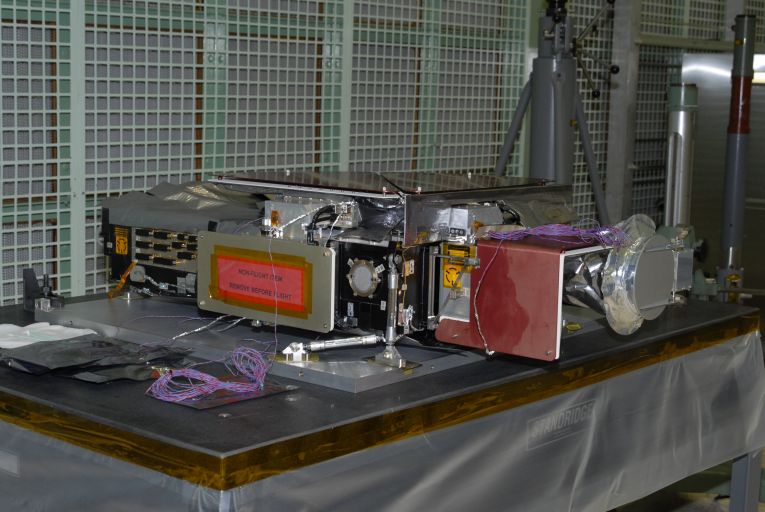
HMI (Helioseismic and Magnetic Imager)
The Helioseismic and Magnetic Imager extends the capabilities of the SOHO/MDI instrument with continual full-disk coverage at higher spatial resolution and new vector magnetogram capabilities. PI: Phil Scherrer, PI Institution: Stanford University.
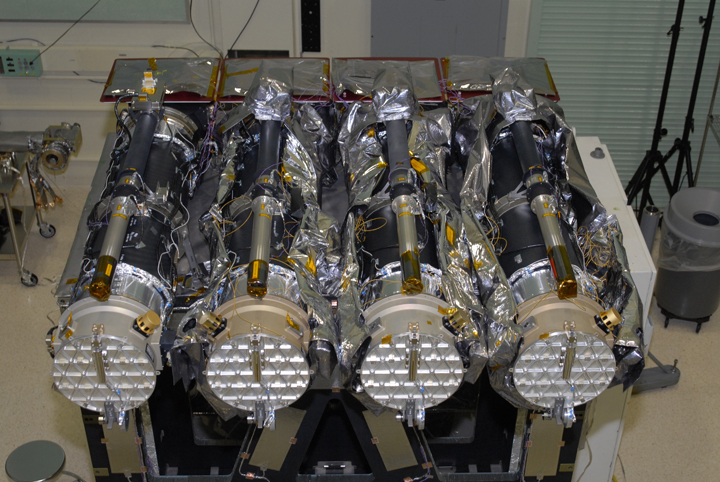
AIA (Atmospheric Imaging Assembly)
The Atmospheric Imaging Assembly images the solar atmosphere in multiple wavelengths to link changes in the surface to interior changes. Data includes images of the Sun in 10 wavelengths every 10 seconds. PI: Alan Title, PI Institution: Lockheed Martin Solar Astrophysics Laboratory.
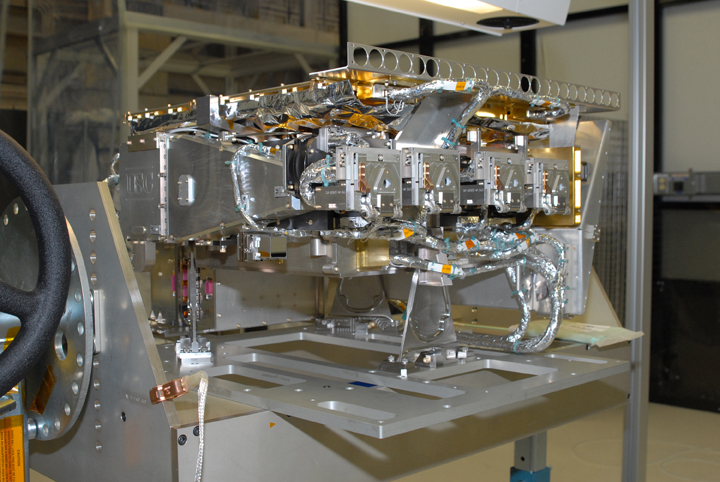
EVE (Extreme Ultraviolet Variability Experiment)
The Extreme Ultraviolet Variability Experiment measures the solar extreme-ultraviolet (EUV) irradiance with unprecedented spectral resolution, temporal cadence, and precision. EVE measures the solar extreme ultraviolet (EUV) spectral irradiance to understand variations on the timescales which influence Earth’s climate and near-Earth space. PI: Tom Woods, PI Institution: University of Colorado.

